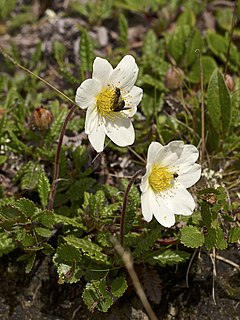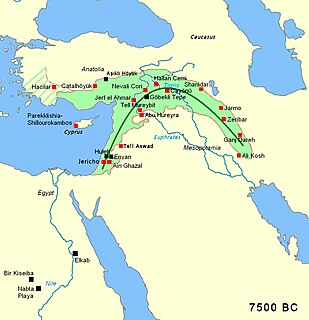Related Research Articles
The Younger Dryas was a return to glacial conditions after the Late Glacial Interstadial, which temporarily reversed the gradual climatic warming after the Last Glacial Maximum (LGM) started receding around 20,000 BP. It is named after an indicator genus, the alpine-tundra wildflower Dryas octopetala, as its leaves are occasionally abundant in late glacial, often minerogenic-rich sediments, such as the lake sediments of Scandinavia.

Dryas octopetala, the mountain avens, eightpetal mountain-avens, white dryas or white dryad, is an Arctic–alpine flowering plant in the family Rosaceae. It is a small prostrate evergreen subshrub forming large colonies. The specific epithet octopetala derives from the Greek octo (eight) and petalon (petal), referring to the eight petals of the flower, an unusual number in the Rosaceae, where five is the normal number. However, flowers with up to 16 petals also occur naturally.

Indigenous Canadians are the indigenous peoples within the boundaries of Canada. They comprise the First Nations, Inuit and Métis. Although "Indian" is a term still commonly used in legal documents, the descriptors "Indian" and "Eskimo" have somewhat fallen into disuse in Canada, and some consider them to be pejorative. "Aboriginal" as a collective noun is a specific term of art used in some legal documents, including the Constitution Act, 1982, though in some circles that word is also falling into disfavour.

Dryas is a genus of perennial cushion-forming evergreen dwarf shrubs in the family Rosaceae, native to the arctic and alpine regions of Europe, Asia and North America. The genus is named after the dryads, the tree nymphs of ancient Greek mythology. The classification of Dryas within the Rosaceae has been unclear. The genus was formerly placed in the subfamily Rosoideae, but is now placed in subfamily Dryadoideae.

The Plano cultures is a name given by archaeologists to a group of disparate hunter-gatherer communities that occupied the Great Plains area of North America during the Paleo-Indian or Archaic period.

The Ahrensburg culture or Ahrensburgian was a late Upper Paleolithic nomadic hunter culture in north-central Europe during the Younger Dryas, the last spell of cold at the end of the Weichsel glaciation resulting in deforestation and the formation of a tundra with bushy arctic white birch and rowan. The most important prey was the wild reindeer. The earliest definite finds of arrow and bow date to this culture, though these weapons might have been invented earlier. The Ahrensburgian was preceded by the Hamburg and Federmesser cultures and superseded by the Maglemosian and Swiderian cultures. Ahrensburgian finds were made in southern and western Scandinavia, the North German plain and western Poland. The Ahrensburgian area also included vast stretches of land now at the bottom of the North and Baltic Sea, since during the Younger Dryas the coastline took a much more northern course than today.
The Nordic Stone Age refers to the Stone Age of Scandinavia. During the Weichselian glaciation, almost all of Scandinavia was buried beneath a thick permanent ice cover and the Stone Age came rather late to this region. As the climate slowly warmed up at the end of the ice age, nomadic hunters from central Europe sporadically visited the region, but it was not until around 12,000 BCE before permanent, but nomadic, habitation took root.

The Late Pleistocene is an unofficial age in the international geologic timescale in chronostratigraphy, also known as Upper Pleistocene from a stratigraphic perspective. It is intended to be the fourth division of the Pleistocene Epoch within the ongoing Quaternary Period. It is currently estimated to span the time between c. 129,000 and c. 11,700 years ago. The Late Pleistocene equates to the proposed Tarantian Age of the geologic time scale, preceded by the officially ratified Chibanian and succeeded by the officially ratified Greenlandian. The estimated beginning of the Tarantian is the start of the Eemian interglacial period. It is held to end with the termination of the Younger Dryas, some 11,700 years ago when the Holocene Epoch began.
The Older Dryas was a stadial (cold) period between the Bølling and Allerød interstadials, about 14,000 years Before Present), towards the end of the Pleistocene. Its date is not well defined, with estimates varying by 400 years, but its duration is agreed to have been around 200 years.

The Oldest Dryas is a biostratigraphic subdivision layer corresponding to an abrupt cooling event, or stadial, which occurred during the last glacial retreat. The time period to which the layer corresponds varies between regions, but it is generally dated as starting at 18.5-17 ka BP and ending 15-14 ka BP. As with the Younger and Older Dryas events, the stratigraphic layer is marked by abundance of the pollen and other remains of Dryas octopetala, an indicator species that colonizes arctic-alpine regions.

In paleoclimatology of the Holocene, the Boreal was the first of the Blytt-Sernander sequence of north European climatic phases that were originally based on the study of Danish peat bogs, named for Axel Blytt and Rutger Sernander, who first established the sequence. In peat bog sediments, the Boreal is also recognized by its characteristic pollen zone. It was preceded by the Younger Dryas, the last cold snap of the Pleistocene, and followed by the Atlantic, a warmer and moister period than our most recent climate. The Boreal, transitional between the two periods, varied a great deal, at times having within it climates like today's.

Doggerland was an area of land, now submerged beneath the southern North Sea, that connected Great Britain to continental Europe. It was flooded by rising sea levels around 6500–6200 BCE. Geological surveys have suggested that it stretched from where Great Britain's east coast now is to the present-day Netherlands, western coast of Germany, and peninsula of Jutland. It was probably a rich habitat with human habitation in the Mesolithic period, although rising sea levels gradually reduced it to low-lying islands before its final submergence, possibly following a tsunami caused by the Storegga Slide. Doggerland was named after the Dogger Bank, which in turn was named after 17th-century Dutch fishing boats called doggers.

The Pre-Pottery Neolithic (PPN) represents the early Neolithic in the Levantine and upper Mesopotamian region of the Fertile Crescent, dating to c. 12,000 – c. 8,500 years ago, that is 10,000-6,500 BCE. It succeeds the Natufian culture of the Epipalaeolithic Near East, as the domestication of plants and animals was in its formative stages, having possibly been induced by the Younger Dryas. The Pre-Pottery Neolithic culture came to an end around the time of the 8.2 kiloyear event, a cool spell centred on 6200 BCE that lasted several hundred years. It is succeeded by the Pottery Neolithic.
Prehistory, also known as pre-literary history, is the period of human history between the use of the first stone tools by hominins c. 3.3 million years ago and the invention of writing systems. The use of symbols, marks, and images appears very early among humans, but the earliest known writing systems appeared c. 5,300 years ago and it took thousands of years for writing systems to be widely adopted. In some human cultures, writing systems were not used until the nineteenth century and, in a few, not even until the present. The end of prehistory therefore came at very different dates in different places, and the term is less often used in discussing societies where prehistory ended relatively recently.

Weichselian glaciation refers to the last glacial period and its associated glaciation in northern parts of Europe. In the Alpine region it corresponds to the Würm glaciation. It was characterized by a large ice sheet that spread out from the Scandinavian Mountains and extended as far as the east coast of Schleswig-Holstein, the March of Brandenburg and Northwest Russia.

The Alaska-St. Elias Range tundra is an ecoregion of northwestern North America.

The Beringia upland tundra is a mountainous tundra ecoregion of North America, on the west coast of Alaska.

Montane ecosystems are found on the slopes of mountains. The alpine climate in these regions strongly affects the ecosystem because temperatures fall as elevation increases, causing the ecosystem to stratify. Dense montane forests are common at moderate elevations, due to moderate temperatures and high rainfall. At higher elevations, the climate is harsher, with lower temperatures and higher winds, preventing the growth of trees and causing the plant community to transition to montane grasslands, shrublands or alpine tundra.

Dryas integrifolia is a species of flowering plant in the rose family known by the common names arctic avens, entireleaf mountain-avens, white mountain-avens, northern white mountain avens, and mountain avens. It is native to northern parts of North America, where it occurs from Alaska across Canada to Greenland. It is a common species of the Arctic and it is probably the most common flowering plant on some of the western Arctic islands.
References
| | This article about geography terminology is a stub. You can help Wikipedia by expanding it. |